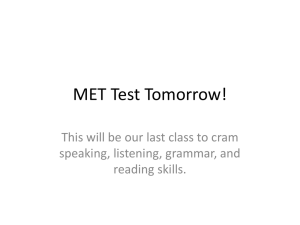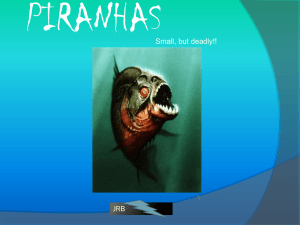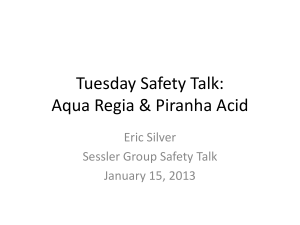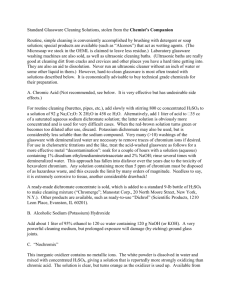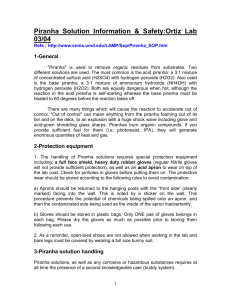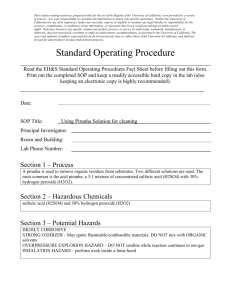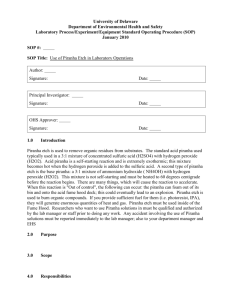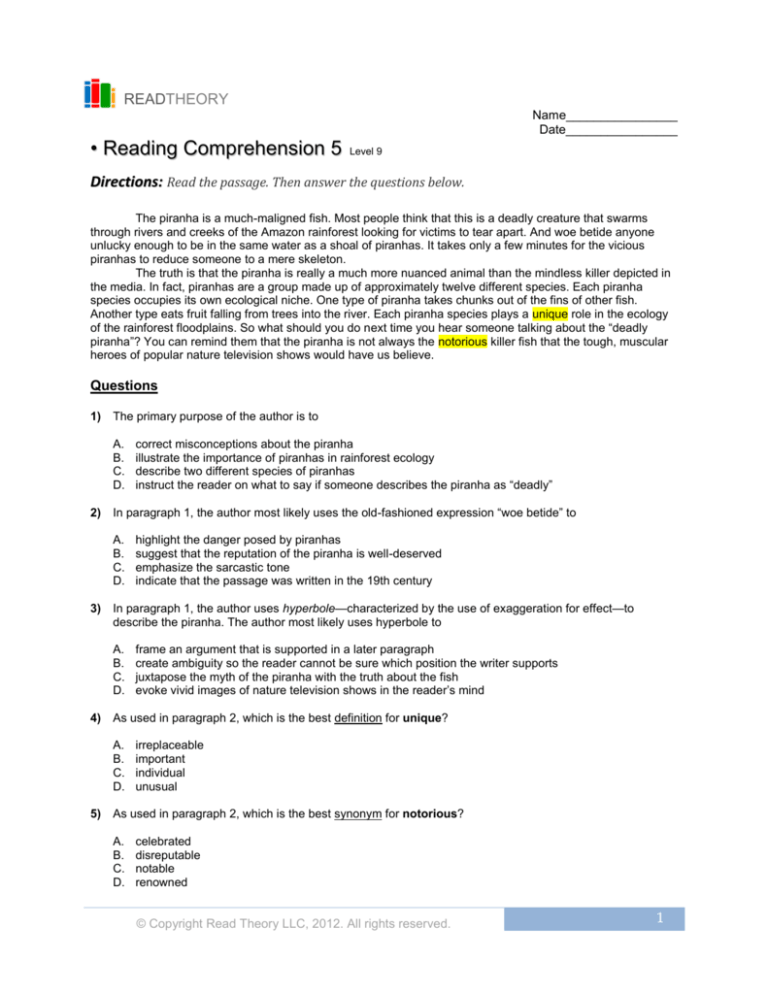
READTHEORY
Name________________
Date________________
• Reading Comprehension 5
Level 9
Directions: Read the passage. Then answer the questions below.
The piranha is a much-maligned fish. Most people think that this is a deadly creature that swarms
through rivers and creeks of the Amazon rainforest looking for victims to tear apart. And woe betide anyone
unlucky enough to be in the same water as a shoal of piranhas. It takes only a few minutes for the vicious
piranhas to reduce someone to a mere skeleton.
The truth is that the piranha is really a much more nuanced animal than the mindless killer depicted in
the media. In fact, piranhas are a group made up of approximately twelve different species. Each piranha
species occupies its own ecological niche. One type of piranha takes chunks out of the fins of other fish.
Another type eats fruit falling from trees into the river. Each piranha species plays a unique role in the ecology
of the rainforest floodplains. So what should you do next time you hear someone talking about the “deadly
piranha”? You can remind them that the piranha is not always the notorious killer fish that the tough, muscular
heroes of popular nature television shows would have us believe.
Questions
1)
The primary purpose of the author is to
A.
B.
C.
D.
2)
In paragraph 1, the author most likely uses the old-fashioned expression “woe betide” to
A.
B.
C.
D.
3)
frame an argument that is supported in a later paragraph
create ambiguity so the reader cannot be sure which position the writer supports
juxtapose the myth of the piranha with the truth about the fish
evoke vivid images of nature television shows in the reader’s mind
As used in paragraph 2, which is the best definition for unique?
A.
B.
C.
D.
5)
highlight the danger posed by piranhas
suggest that the reputation of the piranha is well-deserved
emphasize the sarcastic tone
indicate that the passage was written in the 19th century
In paragraph 1, the author uses hyperbole—characterized by the use of exaggeration for effect—to
describe the piranha. The author most likely uses hyperbole to
A.
B.
C.
D.
4)
correct misconceptions about the piranha
illustrate the importance of piranhas in rainforest ecology
describe two different species of piranhas
instruct the reader on what to say if someone describes the piranha as “deadly”
irreplaceable
important
individual
unusual
As used in paragraph 2, which is the best synonym for notorious?
A.
B.
C.
D.
celebrated
disreputable
notable
renowned
© Copyright Read Theory LLC, 2012. All rights reserved.
1
Answers and Explanations
1) A
An author’s purpose is related to the content of the passage. In the first sentence the author describes the piranha as “muchmaligned.” Even if the reader does not know that this phrase means that people speak harmful untruths about the piranha, the
reader can infer this meaning from the following sentences. The next sentence identifies what “most people think” about the piranha:
that it is “deadly” and “vicious,” always “looking for victims to tear apart.” The deliberate exaggeration of the language indicates that
the author is mocking common misconceptions about the piranha. In contrast, the next paragraph begins, “The truth is that the
piranha is really a much more nuanced animal than the mindless killer depicted in the media.” This paragraph goes on to describe
accurate facts about piranhas, which contradict the misconceptions identified in paragraph 1. This structure suggests that the
author’s primary purpose is to correct misconceptions about the piranha. Therefore (A) is correct. Although the author briefly
mentions the role of piranhas in rainforest ecology, he or she uses this detail to support the larger argument that most people are
misinformed about the piranha. This means (B) is incorrect. The author does provide facts about two different species of piranha,
but he or she uses these details to support the larger argument that most people are misinformed about the piranha. This makes (C)
incorrect. In the final sentence, the author instructs the reader on what to say the next time they hear someone “talking about the
‘deadly piranha.’” However, this minor point is used to reinforce the larger point that nature television shows often portray the
piranha inaccurately, furthering misconceptions. This means instructing the reader on what to say in this situation is not the author’s
primary purpose, so (D) is incorrect.
2) C
In modern writing, the old-fashioned expression “woe betide” is rarely used. It is so uncommon that its use today often draws
attention to itself, and therefore it becomes a comedic or exaggerated element. In this passage, the author mockingly describes
“what most people” think about the piranha. In paragraph 1, the author writes: “And woe betide anyone unlucky enough to be in the
same water as a shoal of piranhas.” Even if the reader does not know the literal meaning of “woe betide,” it can be inferred from the
sentence above that it means something like “misery will come to.” The author also uses exaggerated adjectives such as “deadly”
and “vicious” to describe the fish in a tongue-in-cheek manner. The sarcastic depiction of the piranha as deadly in paragraph 1
contrasts with what the author clarifies as “the truth” about the piranha in the following paragraph—that it is not a “mindless killer.”
Based on this information, the reader can infer that the author most likely uses the old-fashioned phrase “woe betide” to emphasize
the sarcastic tone in paragraph 1. Therefore (C) is correct. In this context, “woe betide” is an expression that introduces a comedic,
sarcastic element. In paragraph 2, the author makes it clear that he or she was not serious in paragraph 1 about the danger posed
by piranhas. Therefore (A) is incorrect. The passage clearly implies that the reputation of the piranha is not well-deserved, but a
misconception. This means (B) is incorrect. The passage does not contain information to indicate when it was written. With the
exception of “woe betide,” the language is modern, and the author even makes a reference to television, which was invented after
the 19th century. Furthermore, the use of one old-fashioned phrase is not a definitive indication of when a passage was written.
Based on this information, we can understand that the old-fashioned expression is being used for effect, not because the passage
was written long ago. Therefore (D) is incorrect.
3) C
The author uses hyperbole in paragraph 1 to describe piranhas as “deadly,” “vicious” creatures that can “reduce someone to a mere
skeleton” in “a few minutes.” This exaggeration contrasts with the factual approach of paragraph 2. This contrast emphasizes the
point that piranhas are not the deadly creatures depicted in popular media. In the paragraph 1, the author creates a mental picture
of piranhas that “tear apart” their “victims.” Yet in paragraph 2, the author refers to piranhas that “eat fruit” and that play “a unique
role in the ecology of the rainforest.” Based on this information we can determine that the author most likely uses hyperbole to
juxtapose the myth of the piranha with the “truth” about the fish in order to persuade the reader that the piranha is not just a
“mindless killer.” Therefore (C) is correct. The use of hyperbole frames the argument of the piranha as deadly. Since this argument
is contradicted in a later paragraph, not supported, (A) is incorrect. The intent of the author is to contrast an exaggerated position
with a factual position. The sarcastic tone and hyperbole in paragraph 1 are clues to suggest that the author supports the factual
position conveyed in paragraph 2. Since the use of hyperbole clarifies the author’s position rather than creates ambiguity, (B) is
incorrect. Although the exaggerated language may evoke vivid images of the piranha in the reader’s mind, the author does not
mention nature television shows until later in the passage, so we can infer that the author did not intend to evoke images of nature
television shows in paragraph 1. Furthermore, the author most likely uses hyperbole not merely to create imagery, but to contrast
the myth of the piranha with the facts. This means (D) is incorrect.
4) C
unique (adjective): existing as the only one or as the sole example; individual.
In paragraph 2, the author writes, “Each piranha species occupies its own ecological niche.” From this we can understand that each
species holds an individual place in the ecosystem. To elaborate on this idea, the author gives two examples of piranha species that
behave differently, and then he or she writes, “Each piranha species plays a unique role in the ecology of the rainforest floodplains.”
From these two sentences, we can infer that the author is using the word unique to indicate that the different species of piranha play
distinct roles in the rainforest ecology. This means that individual is a good definition of unique in this context. Therefore (C) is
correct. The passage does not suggest that each piranha species plays an irreplaceable role in the ecology of the rainforest, merely
that each species plays a distinct role. This means (A) is incorrect. The passage does not provide judgment about whether the roles
of the varying piranha species are important, merely that they are different. This makes (B) incorrect. Although the roles each
piranha species plays are distinct, and therefore different from each other, the passage does not suggest that they are inherently
unusual roles. Therefore (D) is incorrect.
5) B
notorious (adjective): widely and unfavorably known for negative attributes; infamous.
The author writes, “So what should you do next time you hear someone talking about the ‘deadly piranha’? You can remind them
that the piranha is not always the notorious killer fish that the tough, muscular heroes of popular nature television shows would have
us believe.” Here the author uses the word notorious to emphasize the point that piranhas do not deserve their negative reputation,
© Copyright Read Theory LLC, 2012. All rights reserved.
2
even though “the tough muscular heroes of popular nature television shows” depict piranhas as “notorious” and “deadly.” In
paragraph 2 the author also claims piranhas are depicted as “mindless killer[s]…in the media.” Based on this information, the reader
can infer that the media and television shows depict piranhas as something very negative. This means that disreputable is a good
synonym for notorious. Therefore (B) is correct. The author notes that the piranha is depicted in a negative light on “popular nature
television shows” and in the “media.” Celebrated, notable, and renowned all can mean famous in a positive sense, so they are not
good synonyms for notorious. This means that choices (A), (C), and (D) are incorrect.
© Copyright Read Theory LLC, 2012. All rights reserved.
3

